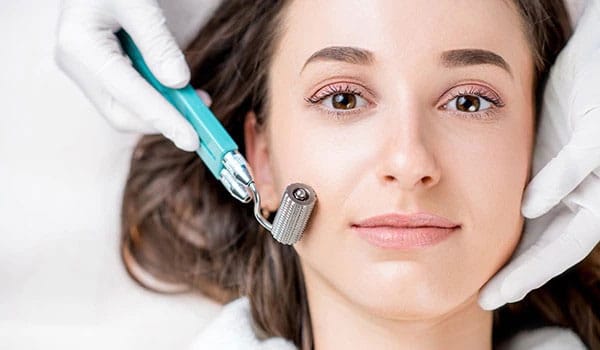Is Dermaroller Safe for Sensitive Skin? 4 Must-Know Tips
You even have to test a product to your skin and wait if you will develop any skin redness and irritation. Even for dermatologist, treating people with sensitive skin can be challenging, as well. So, what if, you want to use dermarolling therapy, is it suitable for sensitive skin like yours?
Will you develop adverse skin reactions if you try rolling microneedles into your skin? What are the effects of dermarolling treatment for sensitive skin? What are some helpful tips that you can apply to prevent any adverse skin reactions?
In here, you will learn more about dermarolling therapy including its safety profile and whether or not it is applicable for sensitive skin individuals like you.
But first, what is dermarolling therapy?
Dermarolling therapy is also popularly known as microneedling therapy. It has other names such as skin needling and percutaneous collagen induction therapy. Dermarolling therapy is classified as skin resurfacing procedure that uses micro or fine needles to induce dermal wounds.[1]
These micro dermal wounds are well-controlled to stimulate the remodeling of the existing collagen and promote the formation of a new collagen and elastin. It also induces vascularization or formation of new blood vessels in the papillary dermis. These activities results in the reduction of wrinkles, fine lines, scars and sagging skin.
Is Dermarolling Therapy Safe for sensitive skin?
Microneedling is considered as a safe skin resurfacing procedure because it has minimal damage to the skin which results in lesser epidermal injury as compared with laser ablation treatment and other conventional treatment. More so, there is a lower risk of having scarring and hyperpigmentation, thus, making it a suitable treatment for persons with sensitive skin, thin skin as well as ethnic type skin.1
So if you have a sensitive skin, you don’t have to worry. You can safely use dermarolling therapy to treat acne, wrinkles, fine lines, and many other skin conditions. [2]
Four Must-know tips for Sensitive Skins When Using Dermarollers
When you have a sensitive skin, you have to be extra careful in taking care of your skin to avoid any adverse skin reactions. Good thing, dermarolling therapy has a good safety profile making it a suitable dermatologic treatment even for those persons having sensitive skin. When using dermarolling therapy, here are some of the tips that you should keep in mind.
Tip 1: Perform the Dermarolling Therapy on the Doctor’s Clinic
Sensitive skin individuals should seek medical consult first before applying anything into their skin. For safety purposes, it is best if you will consult first your dermatologist so he or she can discuss with you the pros and cons of using dermarolling therapy.
The dermatologist will also clearly explain how the treatment will go on, and how many sessions you need to treat the particular skin condition. If you develop any adverse skin reaction, your dermatologist can immediately prescribe alternative medications to treat the condition.
More so, medical dermarollers are used only once, so the treatment process per se, is safer in the doctor’s clinic. They will also used topical anesthesia to numb your skin, and use steroid medications if necessary to prevent unnecessary skin reactions.
If you insists on doing it all by yourself, seek consult first to the dermatologist, if it is possible for your skin type. Preferably, ask the appropriate needle size that is safe for your skin and your doctor’s number so you can call him or her anytime, in case something happens.
Tip 2: Use hypoallergenic and non comedogenic skin care products
After the therapy, your dermatologist will prescribed you some medications like antibiotic creams to prevent any infection that may delay the healing process. If you are using other skin care treatments, better to use hypoallergenic products and non comedogenic products particularly if you intend to use moisturizing creams, anti-aging creams, acne creams, sun screen, lotions, make-up and so on.
Hypoallergenic product doesn’t mean it will not induce an allergic skin reaction but it is less likely to create allergic reaction compared with the regular brands which is not hypoallergenic. More so, non-comedogenic products are those that will not cause blackheads, whiteheads and so on.
This is very important because microneedling therapy can boost the absorption of any topical product that is applied on the skin for the first 24 hours. So it is best that you avoid any products that contain toxic and harmful ingredients.
Tip 3: Avoid direct sun exposure after the therapy
It is best if you will avoid direct sun exposure after your dermarolling therapy. If your dermatologist used 0.5 mm dermaroller, you should avoid sunlight for 24 hours. But if your dermatologist used longer needles like 0.75 mm to 1 mm, you should avoid sunlight for at least two to seven days.
Actually, it depends on the extent of the area of the skin treated.
Tip 4: Rest your skin and wait for complete healing
Sensitive skins may take longer time to recover from dermarolling therapy unlike the normal skin. It may also takes weeks before your skin will attain full recovery. You may also require multiple sessions depending on your skin condition.
Bottomline
Nevertheless, dermarolling therapy is a safe skin resurfacing procedure to use for sensitive skin. You don’t need to worry about having adverse skin reactions because among the different skin resurfacing procedures like lasers, microdermabrasion, plasma resurfacing, laser ablation therapy and many others, dermarolling therapy has the least side-effects noted.
As long as you follow, these four must-know tips, you will not have any adverse skin reactions:
- Perform the Dermarolling Therapy on the Doctor’s Clinic
- Use hypoallergenic and non comedogenic skin care products
- Avoid direct sun exposure after the therapy
- Rest your skin and wait for complete healing
Bibliography
[1] Mathew M Loesch,1 Ally-Khan Somani,1 Melanie M Kingsley,1 Jeffrey B Travers,1,2,3 and Dan F Spandau1,4. (2014). Skin resurfacing procedures: new and emerging options. Clin Cosmet Investig Dermatol. , 231–241.
[2] Doddaballapur, S. (2009). Microneedling with Dermaroller. J Cutan Aesthet Surg , 110–111.
Schedule Your Consultation Today
Make an appointment at Tox Bar, Northern Kentucky’s Neurotoxin, Dermal Filler, and Microneedling experts, encourage all customers and clients to take care of their skin this winter. We’re here to help answer any questions you may have about your skin and it’s proper care. Offering a wide range of solutions to your skin care conundrums, Tox Bar works with each client to create a care plan that will help meet your specific skin care goals.

